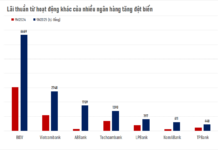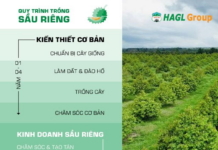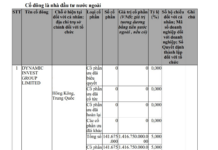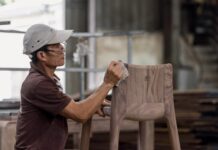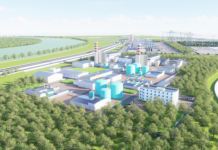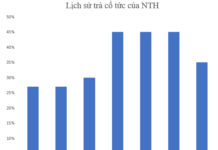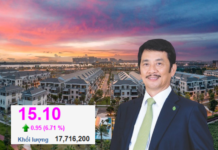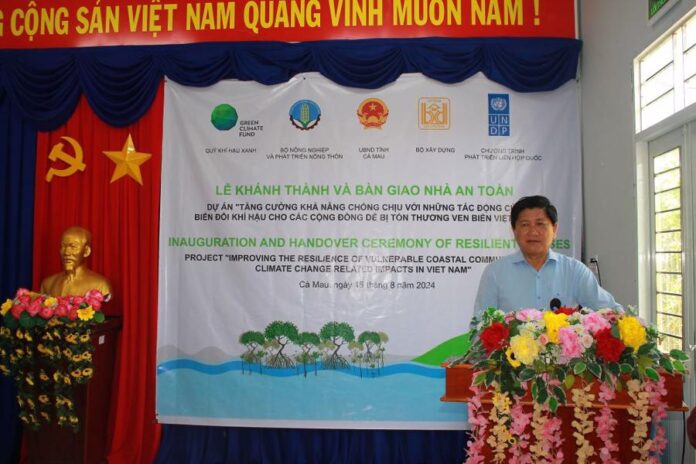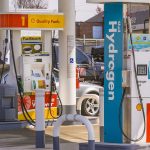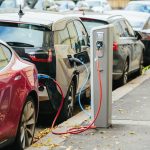On the afternoon of August 15, 2024, in U Minh district, Ca Mau province, the United Nations Development Program (UNDP) in Vietnam, in coordination with the Ca Mau Provincial People’s Committee and the Ministries of Agriculture and Rural Development and Construction, organized the inauguration and handover ceremony of houses under the GCF project.
This event was part of Component 1 of the project “Enhancing Resilience to Climate Change Impacts for Vulnerable Coastal Communities in Vietnam” (also known as the GCF project).
BUILDING DISASTER-RESILIENT HOUSES
Attending the event were Ms. Ramla Khalidi, Resident Representative of the United Nations Development Program (UNDP) in Vietnam; Mr. Le Van Su, Vice Chairman of the Ca Mau Provincial People’s Committee; representatives from the Department of Dikes and Flood Control, Ministry of Agriculture and Rural Development; and representatives from the Department of Housing and Real Estate Market Management, Ministry of Construction, among others.
Mr. Le Van Su, Vice Chairman of the Ca Mau Provincial People’s Committee and a member of the GCF Project Steering Committee, shared that the coastal communities in Ca Mau province have been annually facing and coping with storms, high tides, and harsh conditions caused by climate change. The support from the GCF Project has provided a significant number of poor households in the province with safe housing.

Despite being the latest province to join the project (in March 2024), with the determination of the Project Management Board, the provincial government, and the beneficiary families, the project has successfully constructed 425 safe houses in Ca Mau. The initial target was to build 490 houses for the community, but 65 houses could not be built as the respective households did not meet the criteria set by the GCF Project.
On behalf of the people and the provincial government of Ca Mau, Mr. Le Van Su expressed sincere gratitude to the United Nations Development Program in Vietnam, the Green Climate Fund, the Government, and the central ministries and agencies for their support, which has enabled 425 poor households in the coastal areas of Ca Mau to have safe housing that can withstand storms, high tides, and harsh conditions caused by climate change.
According to Mr. Su, while the GCF Project’s support in constructing 425 houses has significantly helped poor households, there are still many poor households in Ca Mau that lack safe housing. With a 254-kilometer-long coastline and 41 coastal and near-coastal communes, the province wishes for continued support from central ministries and agencies and donors to assist poor households in stabilizing their lives and enhancing their resilience to natural disasters, ultimately helping them escape poverty.
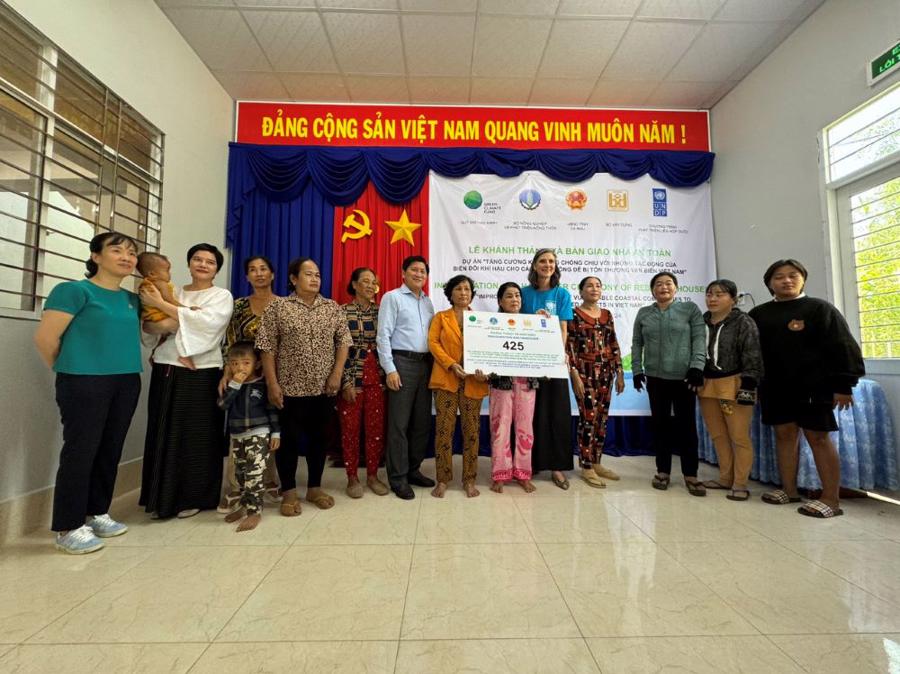
At the ceremony, Mr. Su requested that the beneficiary households cherish this support and make the most of their new homes. He encouraged them to strive to overcome difficulties and escape poverty, not only ensuring safe housing but also working towards a warm and happy life. For households that have not yet received support, he advised them to work towards fulfilling the requirements, especially regarding land ownership, to be eligible for support when more funding becomes available.
GCF PROJECT HAS SUPPORTED THE CONSTRUCTION OF NEARLY 5,000 HOUSES
Ms. Ramla Khalidi, Resident Representative of UNDP in Vietnam, emphasized that the completion of the project has turned the dream of a safe home into a reality for poor coastal communities. This will motivate them to focus on developing sustainable livelihoods and escaping poverty.
According to Ms. Khalidi, a house is an important asset for individuals and families. Therefore, building safe houses is crucial in enhancing the resilience of households in Vietnam’s coastal areas. UNDP is committed to continuing its support to the Vietnamese government in assisting vulnerable communities to live better lives.
Considering the specific conditions in Ca Mau, the safe houses were designed with a height of 4 meters and a usable area ranging from 18 to 40 square meters. The structures are engineered to withstand winds up to level 12 storms. The house foundations are built at least 0.5 meters higher than the highest recorded water level. The houses are designed to last for more than 20 years. The total investment for each house is 105 million VND, including 40 million VND from the project, 40 million VND from the province, and 25 million VND from the beneficiary families. The safe houses are constructed in a similar style, blending in with the architectural landscape of the coastal and lagoon areas.
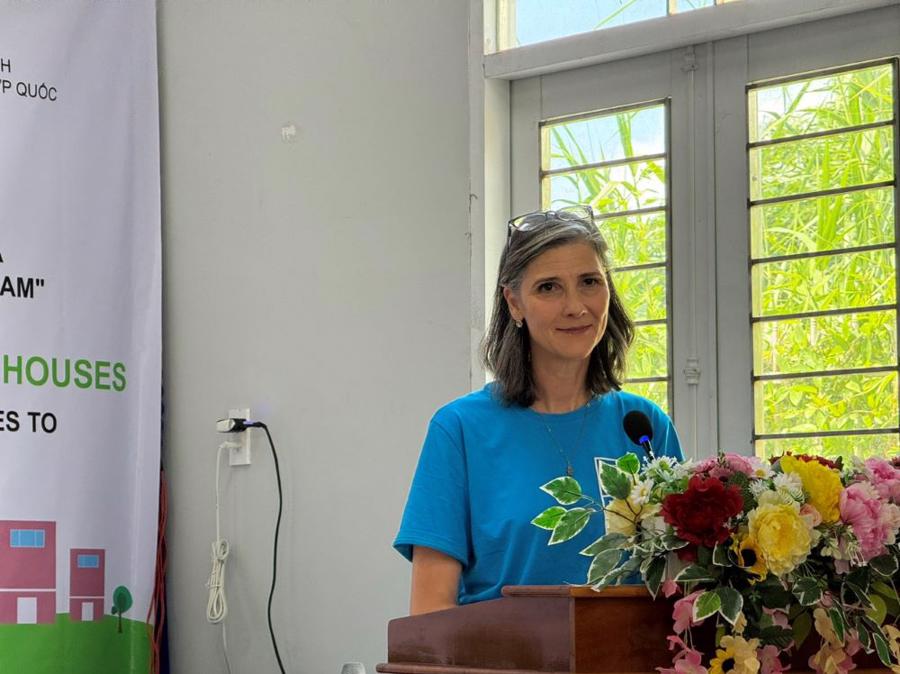
The project “Enhancing Resilience to Climate Change Impacts for Vulnerable Coastal Communities in Vietnam” consists of three components: supporting the construction of flood-resilient houses, planting mangroves, and providing information on disaster risks. The project is being implemented in seven provinces: Nam Dinh, Thanh Hoa, Quang Binh, Thua Thien-Hue, Quang Nam, Quang Ngai, and Ca Mau.
With a duration of five years, from 2019 to 2024, the project aims to strengthen tested interventions to enhance the resilience of vulnerable coastal communities. By incorporating flood-resilient features into new houses, the project will benefit 20,000 poor and at-risk individuals. Additionally, the project will focus on social protection related to housing for poor and disadvantaged households.
“The project’s goal was to build 4,000 new houses with flood-resilient features in safe locations, benefiting 20,000 poor and disaster-affected people. However, to date, nearly 5,000 houses have been completed, far exceeding the initial target.”
Ms. Ramla Khalidi, Resident Representative of UNDP in Vietnam.
Beyond flood risk management, the project will also restore and/or plant 4,000 hectares of mangroves to serve as a buffer against high tides and provide ecosystem resources to support coastal livelihoods. Furthermore, to sustain the project’s impact and facilitate necessary policy adjustments by the government to enhance the resilience of coastal and other communities, resources will be utilized to systematize economic and climate risk assessments for the private and public sectors across Vietnam’s 28 coastal provinces.
Ms. Nguyen Thi Het, a resident of Ap 6, Khanh Lam commune, who received a house under the project, shared her joy: “I never thought I would own a solid house in my lifetime, so I truly cherish it. Before, my family lived in a dilapidated house with a thatched roof and bamboo poles. During heavy rains and whirlwinds, our house would shake and leak. Every rainy night, we felt insecure. Now, with the project’s support of 80 million VND, we have a sturdy house. I am deeply moved and grateful to the government and international organizations for their help.”
Mr. Nguyen Minh Thong, Chairman of the People’s Committee of Khanh Lam commune, U Minh district, shared that Khanh Lam is an extremely disadvantaged commune, with a poverty rate of 8%, the second highest in U Minh district. There are still 282 poor households in the commune, and over 220 households in need of housing support. Through this program, 59 houses have been built in Khanh Lam, the highest number among all communes in the province. These houses were completed before June 10, 2024, making Khanh Lam the first commune to finish construction. The houses are well-built and can withstand storms, enabling poor families to focus on improving their lives.
Hydrogen-powered cars outshine electric vehicles, but the truth is disappointing: A major player hastily retreats, shutting down a series of refueling stations.
A series of hydrocharging stations in the capital city of California (USA) have recently been shut down.






